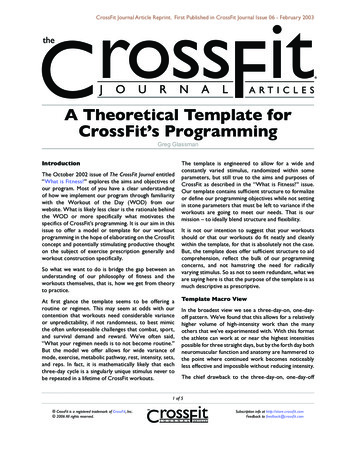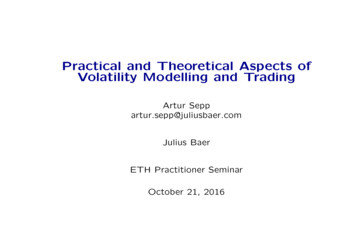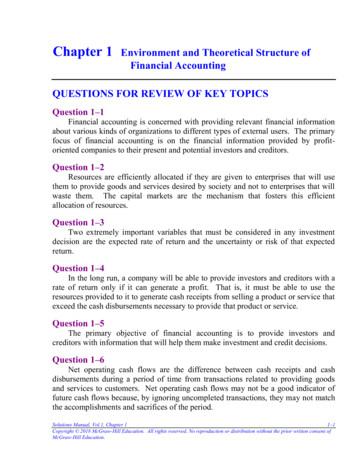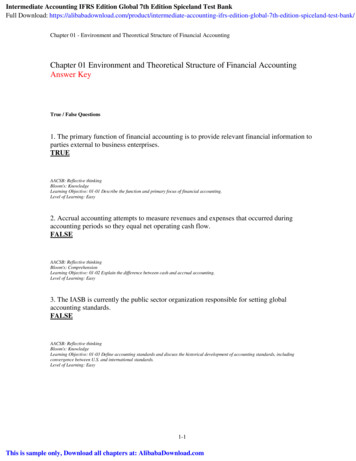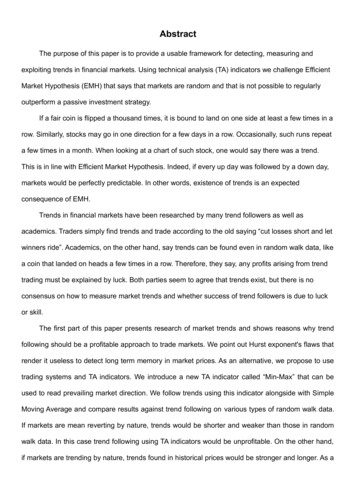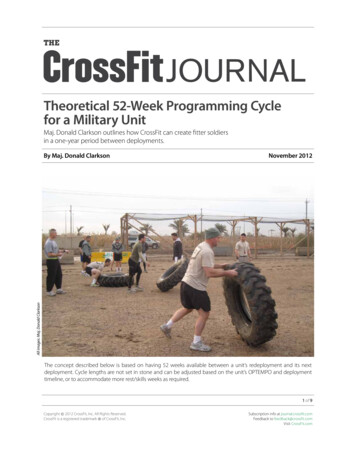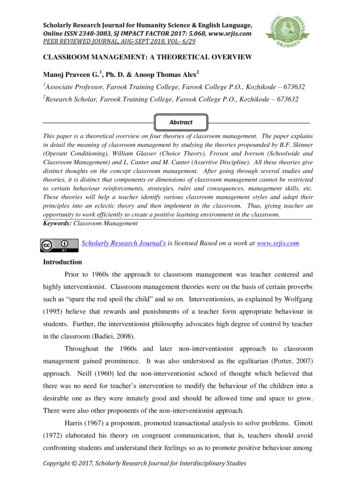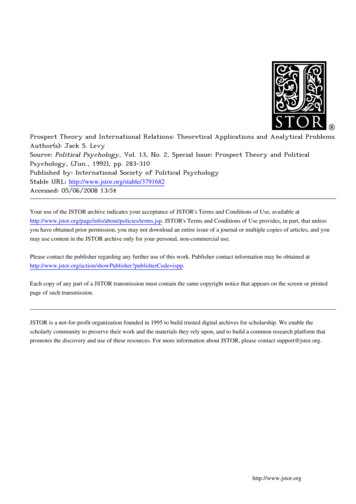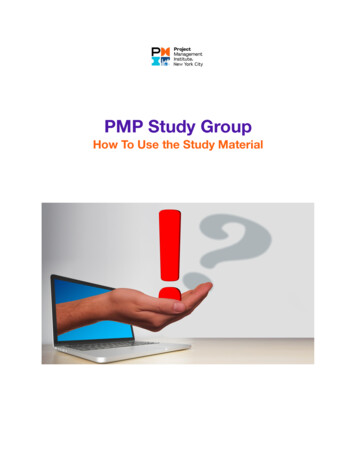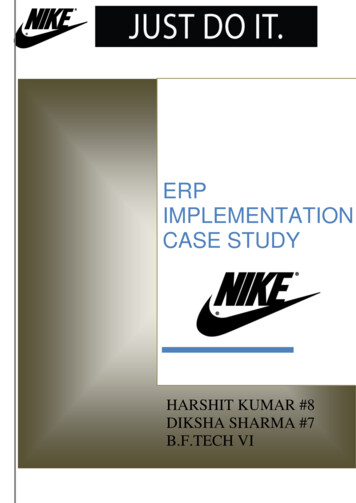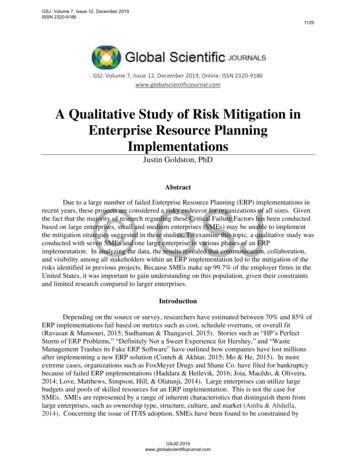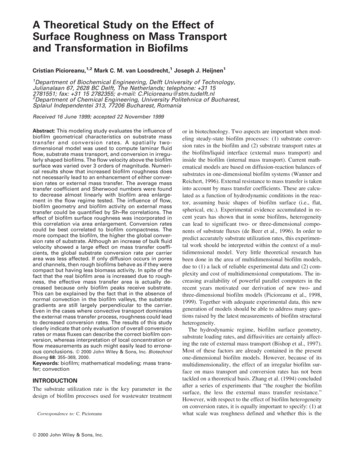
Transcription
A Theoretical Study on the Effect ofSurface Roughness on Mass Transportand Transformation in BiofilmsCristian Picioreanu,1,2 Mark C. M. van Loosdrecht,1 Joseph J. Heijnen11Department of Biochemical Engineering, Delft University of Technology,Julianalaan 67, 2628 BC Delft, The Netherlands; telephone: 31 152781551; fax: 31 15 2782355; e-mail: C.Picioreanu@stm.tudelft.nl2Department of Chemical Engineering, University Politehnica of Bucharest,Splaiul Independentei 313, 77206 Bucharest, RomaniaReceived 16 June 1999; accepted 22 November 1999Abstract: This modeling study evaluates the influence ofbiofilm geometrical characteristics on substrate masstransfer and conversion rates. A spatially twodimensional model was used to compute laminar fluidflow, substrate mass transport, and conversion in irregularly shaped biofilms. The flow velocity above the biofilmsurface was varied over 3 orders of magnitude. Numerical results show that increased biofilm roughness doesnot necessarily lead to an enhancement of either conversion rates or external mass transfer. The average masstransfer coefficient and Sherwood numbers were foundto decrease almost linearly with biofilm area enlargement in the flow regime tested. The influence of flow,biofilm geometry and biofilm activity on external masstransfer could be quantified by Sh–Re correlations. Theeffect of biofilm surface roughness was incorporated inthis correlation via area enlargement. Conversion ratescould be best correlated to biofilm compactness. Themore compact the biofilm, the higher the global conversion rate of substrate. Although an increase of bulk fluidvelocity showed a large effect on mass transfer coefficients, the global substrate conversion rate per carrierarea was less affected. If only diffusion occurs in poresand channels, then rough biofilms behave as if they werecompact but having less biomass activity. In spite of thefact that the real biofilm area is increased due to roughness, the effective mass transfer area is actually decreased because only biofilm peaks receive substrate.This can be explained by the fact that in the absence ofnormal convection in the biofilm valleys, the substrategradients are still largely perpendicular to the carrier.Even in the cases where convective transport dominatesthe external mass transfer process, roughness could leadto decreased conversion rates. The results of this studyclearly indicate that only evaluation of overall conversionrates or mass fluxes can describe the correct biofilm conversion, whereas interpretation of local concentration orflow measurements as such might easily lead to erroneous conclusions. 2000 John Wiley & Sons, Inc. BiotechnolBioeng 68: 355–369, 2000.Keywords: biofilm; mathematical modeling; mass transfer; convectionINTRODUCTIONThe substrate utilization rate is the key parameter in thedesign of biofilm processes used for wastewater treatmentCorrespondence to: C. Picioreanu 2000 John Wiley & Sons, Inc.or in biotechnology. Two aspects are important when modeling steady-state biofilm processes: (1) substrate conversion rates in the biofilm and (2) substrate transport rates atthe biofilm/liquid interface (external mass transport) andinside the biofilm (internal mass transport). Current mathematical models are based on diffusion-reaction balances ofsubstrates in one-dimensional biofilm systems (Wanner andReichert, 1996). External resistance to mass transfer is takeninto account by mass transfer coefficients. These are calculated as a function of hydrodynamic conditions in the reactor, assuming basic shapes of biofilm surface (i.e., flat,spherical, etc.). Experimental evidence accumulated in recent years has shown that in some biofilms, heterogeneitycan lead to significant two- or three-dimensional components of substrate fluxes (de Beer et al., 1996). In order topredict accurately substrate utilization rates, this experimental work should be interpreted within the context of a multidimensional model. Very little theoretical research hasbeen done in the area of multidimensional biofilm models,due to (1) a lack of reliable experimental data and (2) complexity and cost of multidimensional computations. The increasing availability of powerful parallel computers in therecent years motivated our derivation of new two- andthree-dimensional biofilm models (Picioreanu et al., 1998,1999). Together with adequate experimental data, this newgeneration of models should be able to address many questions raised by the latest measurements of biofilm structuralheterogeneity.The hydrodynamic regime, biofilm surface geometry,substrate loading rates, and diffusivities are certainly affecting the rate of external mass transport (Bishop et al., 1997).Most of these factors are already contained in the presentone-dimensional biofilm models. However, because of itsmultidimensionality, the effect of an irregular biofilm surface on mass transport and conversion rates has not beentackled on a theoretical basis. Zhang et al. (1994) concludedafter a series of experiments that “the rougher the biofilmsurface, the less the external mass transfer resistance.”However, with respect to the effect of biofilm heterogeneityon conversion rates, it is equally important to specify: (1) atwhat scale was roughness defined and whether this is the
only relevant measure describing biofilm surface irregularity and (2) what was the range of fluid velocities in whichthe measurements were done. As we will demonstrate later,with respect to flow patterns over the biofilms, the standarddefinition of roughness is not enough to characterize thesurface shape. Two “hilly” surfaces having the same standard deviation from the mean line (seen as the coefficient ofroughness: Murga et al., 1995; Picioreanu et al., 1998) canexpose very different surface areas. Roughness describes ingeneral the depth of biofilm valleys. The width of the valleys, seen as the distance between separate clusters is alsoimportant, fact recently recognized also by Stoodley et al.(1999).A main disputed problem is the relevance of convectionin biofilm channels and pores. Since Stoodley et al. (1994)and Lewandowski et al. (1995) made clear that inert micrometer-sized particles can be transported through biofilmchannels, the above problem continues to puzzle many biofilm researchers. Conceptual questions occur because thepresence of flow itself does not necessarily mean that convective transport of nutrients is significant. De Beer andStoodley (1995) experimentally demonstrated that, as expected, convection in biofilm valleys is significant only athigh bulk flow velocities. By using a very simplified threedimensional model, Rittmann et al. (1999) showed that theaverage flux of nutrient per carrier area can be increased bythe cluster-and-channel type of biofilm only if there isenough convection in the open channels (that we call “valleys”). However, being based on pure diffusion-reactionmass balances, their model does not consider fluid dynamicsand thus, cannot explain how and when convection wouldarise in the valleys. The mathematical model we formulatein this study does include fluid flow equations and canaccount for convective substrate transport. Thus, our modelscan explain, on a quantitative basis, when the substrate fluxto the biofilm is really increased by liquid circulation inbiofilm valleys.A final goal should be finding mathematical correlationsbetween mass transport parameters and the measures of biofilm heterogeneity. External mass transfer parameters inbiofilms (e.g., Sherwood number) were often correlatedwith the hydrodynamic regime existing in the bioreactor(e.g., through Reynolds and Schmidt numbers). Geometricalratios between different characteristic lengths of the fullscale system also enter these correlations under certain circumstances. However, geometrical parameters for microscale heterogeneity are rarely included in engineering correlations. Well-known examples are relations for frictionfactor calculation in turbulent flow through pipes, usuallyexpressed as a function of pipe wall roughness. To ourknowledge, no such experimental or theoretical correlationhas been made between Sh number and a measure of biofilm surface irregularity (e.g., roughness, thickness, or areaenlargement).The aim of this study is to predict theoretically the influence of biofilm structural characteristics (roughness, compactness, or area enlargement as defined in Picioreanu et al.356(1998)) on substrate (growth-limiting nutrients) mass transfer and conversion into the biofilm. Starting from basicprinciples of momentum and mass conservation laws, thegoal is to predict mass transfer coefficients and conversionrates for different biofilm surface geometries. The significance of convective transport in biofilm systems will be alsoinvestigated from a theoretical point of view.MODEL DESCRIPTIONChoice of the Model SystemThe computational biofilm system, , is contained in arectangular domain. It consists of two compartments (seeFig. 1): the bulk liquid 1 and the solid biofilm 2, separated by an interface . Liquid flow is driven by moving thetop plate with a constant velocity, uX,max. The system resembles Couette flow between two parallel plates, with thebiofilm surface at the bottom plate. Inlet and outlet flowboundaries (left and right sides on Fig. 1) are periodic, inorder to minimize the entrance effects on the calculatedflow pattern. This is as if, from a hydrodynamic point ofview, the rough biofilm surface would continue infinitelyand we compute the flow field only in a narrow windowof it.A no-slip condition (zero flow velocity) was set at thebiofilm–liquid interface. According to Lewandowski et al.(1995) and Stoodley et al. (1997), the “biofilm” is definedas all the biomass clusters and liquid channels situated between a virtual plane at the maximum biofilm thickness, f,max, and the substratum. Using this definition, we mighterroneously conclude that a slip boundary condition (i.e.,non-zero components of velocities due to flow in the channels) must be set at the “biofilm” surface, i.e., at y ⳱ f,max.Whereas a one-dimensional biofilm model including fluidflow could use the slip-boundary, in a two-dimensionalmodel the liquid phase and the biofilm phase (containing geland biomass) can be completely separated. In our definition,only the biomass clusters belong to the “biofilm,” so that azero-velocity condition can be set at the gel–water interface.Figure 1. System description and boundary conditions.BIOTECHNOLOGY AND BIOENGINEERING, VOL. 68, NO. 4, MAY 20, 2000
However, there is a restriction also in this case: the no-slipboundary condition is valid only when the biofilm clustersare immobile. Many natural biofilms are flexible structures,and therefore oscillations induced by the flow can occur(Stoodley et al., 1998). This movement can create turbulence and can enhance the mass transfer of nutrients(Kugaprasatham et al., 1992). Although in some cases mobile biofilm filaments are probably more relevant, for simplicity, our present model considers only rigid and immobile structures.For the mass transfer equation, a constant substrate concentration is fixed at the inlet boundary. The zero concentration gradient condition is specified at the outlet boundary.We assume that the thickness of the concentration boundarylayer is smaller than the height of our computational domain. Consequently, a zero flux condition is applied also onthe top boundary. The biofilm layer extends over the wholecarrier surface, having for all simulated cases an averagethickness of f ⳱ 145 m. Impermeable walls border thebiofilm at left, right and bottom side (Fig. 1). The aboveconditions imply a “fully developed” flow field but an “entrance region” regime for mass transfer, which is the consequence of liquid flow in a closed system, while masstransport of substrate occurs in an open system. There areseveral good reasons for using such an idealized system.First, the choice of this model system has its roots in ascale analysis of momentum and mass boundary layers. Therelative thickness of the two boundary layers is determinedby the cubic root of Schmidt number (Sc). Due to the highSc numbers (e.g., 500) in liquid systems, the hydrodynamicboundary layer (HBL) is much thicker than the concentration boundary layer (CBL) (e.g., by a factor 8). When theentire concentration boundary layer is embedded within asmall part of the momentum boundary layer, one may assume a linear velocity profile. This is in fact the Lévêqueapproximation employed in the similarity solution for theentrance region of a tube with specified wall concentrationor temperature (Graetz problem; for example, see Deen,1998). This linearization reflects the fact that the curvaturein the parabolic velocity profile is not evident very near thewalls. Couette flow between two parallel plates would produce exactly this linear x velocity profile, if only the biofilmsurface was perfectly flat. What we calculate here is in facta perturbation of this velocity profile due to a solid roughbiofilm boundary. Experimental evidence supporting thisassumption can be found in Stoodley et al. (1994), de Beerand Stoodley (1995), Lewandowski et al. (1995), Bishop etal. (1997), and Stoodley et al. (1997). All these studiesmeasured liquid velocity and concentration profiles near tothe wall of a flow cell with and without biofilm. They foundvelocity profiles approximately linear up to 500–1000 maway from the biofilm surface, for average bulk liquid velocities between 0.001 and 0.1 m/s. The CBL was observedto be contained within this thickness. In the present modeling study we used top liquid velocities (at 255 m above theaverage biofilm surface) varying over 3 orders of magnitudefrom 0.0001 to 0.13 m/s. Our calculations are thereforeperformed only in this quasi-linear region of the HBL. Inreality, velocity continues to vary in the whole liquid layerabove the biofilm. Because most of the experimental stud
effect of biofilm surface roughness was incorporated in this correlation via area enlargement. Conversion rates could be best correlated to biofilm compactness. The more compact the biofilm, the higher the global conver- sion rate of substrate. Although an increase of bulk fluid velocity showed a large effect on mass transfer coeffi-cients, the global substrate conversion rate per carrier area .
